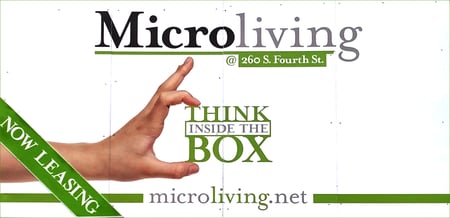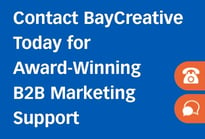Does anything in the billboard ad below compel you to want to move into a “Microliving” apartment? No, because it never gives a reason why you’d want to live in a tiny space, which seems not so pleasant.

This billboard suffers from poor messaging. But your brand doesn’t have to, because we’re going to give you some best practices pointers for creating a strong B2B positioning statement to build your brand messaging around.
Doing the groundwork for your B2B positioning statement
Your positioning statement is a factual, concise description of your target market and your product/service/solution’s unique value proposition—how it serves the customer in a way your competitors can’t or don’t.
Take the following steps to draft your statement:
-
Conduct internal discovery interviews, questionnaires, surveys, and other exercises to gather a clear picture of the marketplace you’re operating in.
-
Identify your target audience, its pain points, and how your solution solves its problems.
-
Gain a good understanding of competing B2B products/solutions and how yours if different.
-
Take a hard, clear-eyed look at your company—its background, its services, general industry information, testimonials, goals, and any research you’ve conducted regarding your company. What’s the promise your brand provides customers? How will your business deliver on that promise?
-
Survey customers about what enticed them to do business with you. Why do they keep doing business with you? What do they get from you that they don’t get from other companies in the same marketplace? What do they see as your company’s core values?
-
Bring in internal stakeholders in a group setting to discuss the organization, purpose, unique characteristics and differentiators, core values, SWOT (strengths, weaknesses, opportunities, threats) analysis, and the character or the relationship between your company and the marketplace.
-
Identify the ways in which you’ll differentiate yourself from the competition when delivering the benefits the market is looking for.
Drill down and sculpt that information until you’ve got a concise positioning statement.
Then put your statement in writing
Some tips for writing your positioning statement:
-
Keep it brief.
-
Make it unique and memorable.
-
Make it true to your business’ core values.
-
Include a credible promise of what your brand delivers to consumers.
-
Communicate how your business is different from the competition.
-
Keep it clear so that your company can use it as a guideline when evaluating whether future business decisions align with your brand.
The foundation for all of your B2B messaging
With a positioning statement around which to build your marketing content, it’s easier to create stronger, more convincing, consistent messaging. Now when visitors interact with your business digitally, they’ll receive a constant, compelling message that communicates your organization’s core values and brand.
But creating a positioning statement isn’t quite as easy as we’ve made it look. So if you need help, BayCreative is here. We’re a full-service B2B marketing/creative/branding agency that has helped dozens of companies create sharp, on-point positioning statements to build their brand messaging around.
Please keep us fresh-in-mind to support this quarter's key marketing initiatives.
All the best,
- Team BayCreative -


